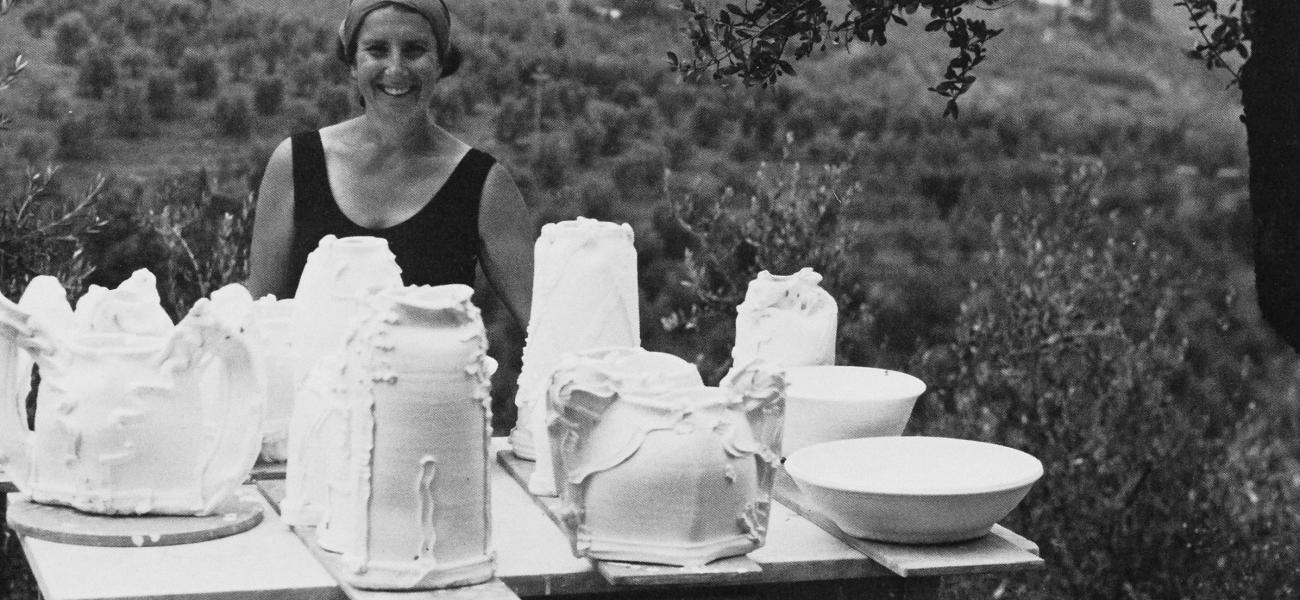The Italian Experience
There is no way for me to write about earthenware without also writing about Italy. In 1951 I arrived there for the first time, presented myself at the door of the Ferfalla Pottery and asked if I could work there. The reply was an amused "why not?" The pottery had been established by Giorgio Ferrero, a painter, and Leonello Fallacara, a sculptor, and at that time consisted of the two artists and two other helpers plus myself. Of course we all made earthenware, a fact which I simply accepted without further thought or question.
Fiesole, where the pottery was located, is an Etruscan town just above Florence. The workshop was right on the edge of the Roman Theatre. Anyone who has been to Italy, or even to Italian films, will understand the impact that the ordered Tuscan landscape had upon me. For centuries the land has been shaped to accommodate man and his needs. The view there was of terraced hillsides covered with silver gray olive trees, vineyards where grapevines grew on low gnarled trees, a wood lot, a double line of black cypress trees leading up to a villa, a church, a graveyard punctuated with more cypress trees, and finally a cluster of farm houses on a hilltop. The reader may wonder what nostalgic musings about the Tuscan landscape have to do with earthenware. For me the physical and cultural context of Italy has had a great deal to do with my development as a potter and has finally led me to earthenware.
After living and working in Italy at various times between 1959 and 1966, my husband and I bought, in 1968, one of those farms on a hilltop outside of Florence, and there I have worked for at least three months of each year ever since. My studio is in the old wine cellar, and the kiln is below it on the terraced hillside, amidst the olive trees and chickens.
For simplicity's sake I shall not discuss art forms other than ceramics which have given me inspiration, pleasure and provocation. Certainly my debt to architecture is apparent. I am still making discoveries about the riches of the ceramic tradition in Italy. Here is an unordered list of clay objects and uses to be observed: Etruscan pots, medieval pitchers, flower pots, olive oil storage jars, roof tiles, Roman pots, floor tiles, majolica, luster, Luca Della Robbia, tiles in architecture from the 15th century to the 20th century, creamy soft paste porcelain, cooking pots. All of the above are low temperature earthenware clay, something I was only mildly interested in for many years.
My aesthetic involvement with these pots was originally in terms of form; profile and weight, handles as an extension of form, and also the pitcher as archetypal pot. I spent many years working from these ideas in stoneware and salt-glazed stoneware. I think that I wanted the distance of using both a different clay and a different kiln to keep me from the dangers of too close a mimicry. Perhaps I was also inhibited by the sense that if I did not use stoneware I was not a real he-man potter! I must admit that my first incentive for using earthenware clay in Italy was practical. For one living and working in Italy three months of every year, it was certainly the most direct solution to the materials problem of ceramics. The only clays available were earthenware because, geologically, Italy is composed of earthenware clay. All of the necessary support materials for ceramics in Italy are appropriate to earthenware. Fuel is expensive, and earthenware costs little to produce. I started making earthenware in Italy in 1968. Today it is much easier to obtain high-fire clays and other necessities for stoneware and porcelain, but fuel costs there are still more than three times what they are in the United States.
The shift to earthenware, while initiated for practical reasons, quickly developed in me an awareness of its material possibilities. The fact that there is little or no movement of the clay in the kiln allows for an exaggeration of form; look at the handles on Greek, Etruscan and Roman pots. A much broader range of color is also possible at low temperature.
Through trips to other Mediterranean countries I have expanded my ceramic experience and broadened my awareness and appreciation of earthenware and the Mediterranean clay tradition. Greece, Turkey, France, Spain, and their historical inspirations-Persian, Hittite, Egyptian, and Chinese-have all contributed to this tradition.
Just as I had felt more at ease transposing the Italian inspired forms to salt glazed stoneware, so I chose to shift the color references of my early earthenware pieces to China and the Tang Dynasty three-color ware, being aware of the pitfalls of too close a mimicry. Meanwhile the forms were thrown and stretched and assembled into something that was probably closer to my fantasy of Mediterranean forms than to the actual models. Keeping touch with tradition so that the pots I made could always be seen in reference to other clay objects, I eventually expanded my palette to include the colors of Islamic pots.
For a time I was diverted to using a terra sigillata surface by the inspiration of a trip to Crete and the overwhelming excitement and pleasure of seeing Minoan pots. This in turn sent me back to revisit the archaeological museum in Florence and the Etruscan pots there. I failed miserably when I first tried to do the terra sigillata. My pots were just too similar to the Minoan ones and yet not nearly as good, so I retreated to baskets, using piercing as a way of treating the sigillata surfaces (the piercing motif came from soft paste porcelain and chimney pots!). Later I timidly reapproached painting, using one color terra sigillata on another with more success, but by then the seduction of liquid color was irresistible.
I like that aspect of clay that takes the object out of my control. What happens to the surface during the firing of the recent Italian-made pieces I can guide but not predict. The same is true for the brightly glazed and painted earthenware I am making in the United States. When the pieces are fired the colors shift and move about in a way which is not totally controlled.
The "window pieces" of my recent Italian work are derived from observations of the controlled exuberance of Baroque architecture, in particular the framing of real or implied openings. The fragmentation of form is part of the clay tradition because size limitations often require many tiles or sections to go together to make a whole, as in Luca Della Robbia, for example. The windows are, at the same time, containers or vases. This work is also a response to the current interest in and involvement with decoration and its relationship to architecture and ornamentation on the part of artists. It continues the art-craft dialogue by presenting the "window" in an art gallery context as observation of ornament or frame rather than reality.
My aesthetic decisions are usually involved with my technical ones. Only in earthenware is it possible to explore elaborately extended handles which can develop and even become the primary form themselves (look at those Greek pots!). While the clay does not move in the kilns in the work done in the United States, the glaze does, and the contradiction is exciting and right and ties into the fluidity of the thrown clay. While in some ways the surfaces of my painted pots may seem a contradiction, in other ways they are a reiteration of the shape. On the "Italian" pots there is an applied, extruded slip used in somewhat the same way. The slip tends to reoxidize, allowing the play of color on the surface of the pots. The forms are more elaborate or baroque, the surface less so.
The use of lead glazes is choice motivated by tradition. Most historic examples of glazed earthenware have lead-based glazes. It has a particular beauty, soft and shiny. Function in my earthenware work has to do with flowers or perhaps presenting fruit or the mail. Orange juice could not be stored in pillow pitchers. They leak and hold at least four gallons. If I make a functional object such as a teapot or cup, I am careful to use a non-lead glaze inside.
In exploring earthenware I wanted to move away from the many functional pots I had made in stoneware and porcelain. In searching for that unknown referred to earlier, I am not as interested in actual function as in taking an artistic stance about function, that is, function out of the context of use. This is why I have been able to permit myself the luxury of lead glazes.


